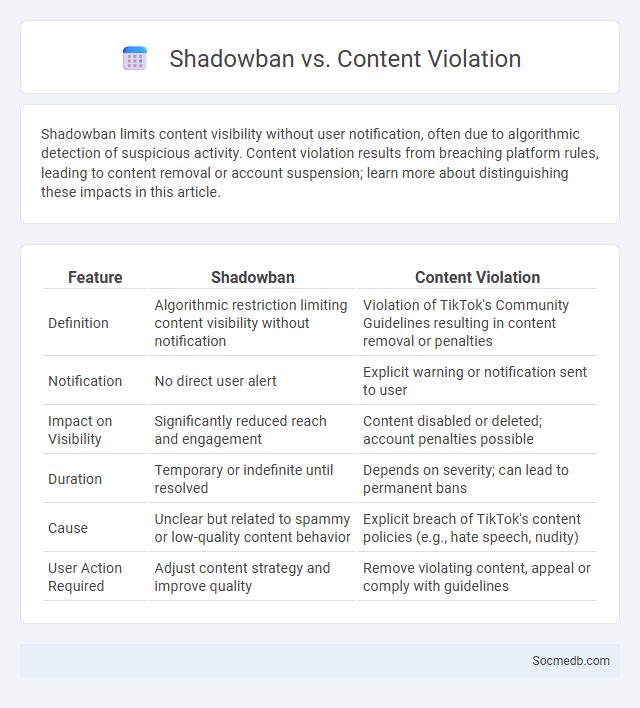
Photo illustration: Shadowban vs Content Violation
Shadowban limits content visibility without user notification, often due to algorithmic detection of suspicious activity. Content violation results from breaching platform rules, leading to content removal or account suspension; learn more about distinguishing these impacts in this article.
Table of Comparison
| Feature | Shadowban | Content Violation |
|---|---|---|
| Definition | Algorithmic restriction limiting content visibility without notification | Violation of TikTok's Community Guidelines resulting in content removal or penalties |
| Notification | No direct user alert | Explicit warning or notification sent to user |
| Impact on Visibility | Significantly reduced reach and engagement | Content disabled or deleted; account penalties possible |
| Duration | Temporary or indefinite until resolved | Depends on severity; can lead to permanent bans |
| Cause | Unclear but related to spammy or low-quality content behavior | Explicit breach of TikTok's content policies (e.g., hate speech, nudity) |
| User Action Required | Adjust content strategy and improve quality | Remove violating content, appeal or comply with guidelines |
Understanding Shadowban: Definition and Impact
Shadowban refers to the practice where social media platforms secretly limit the visibility of a user's content without notification, significantly reducing engagement and reach. Your posts may appear normal to you but become practically invisible to a broader audience, impacting follower growth and interaction rates. Understanding the mechanics of shadowbanning can help you identify if your account is affected and adjust content strategies to regain visibility.
What is Content Violation?
Content violation on social media refers to the posting or sharing of material that breaches platform guidelines or community standards, including hate speech, nudity, harassment, or misinformation. Platforms like Facebook, Instagram, and Twitter use automated systems and human moderators to detect and remove such violating content to maintain a safe environment. Repeated violations can result in account suspension or permanent bans, emphasizing the importance of adhering to content policies.
Shadowbanning Explained: Myths vs. Reality
Shadowbanning on social media refers to the practice of limiting content visibility without notifying the user, causing posts to reach fewer people unexpectedly. Many believe shadowbanning is a widespread secret punishment, but in reality, it often results from algorithmic filtering, content policy enforcement, or user engagement drops. Understanding these nuances helps you address visibility issues effectively without falling for common misconceptions.
Key Differences: Shadowban vs Content Violation
Shadowban subtly limits a user's content visibility without notification, reducing organic reach across platforms like Instagram and Twitter. Content violations involve explicit breaches of community guidelines, often resulting in content removal, warnings, or account suspension. While shadowbanning targets engagement suppression, content violations address rule enforcement based on specific platform policies.
How Platforms Detect and Enforce Shadowbans
Social media platforms detect shadowbans through algorithms that analyze user behavior, engagement patterns, and content quality signals to identify potential violations of community guidelines. Machine learning models monitor suspicious activities such as spamming, inappropriate hashtags, or abrupt changes in interaction rates, triggering shadowban enforcement without direct notification. Your content visibility may be reduced automatically, making it crucial to adhere to platform rules and maintain authentic engagement to avoid these restrictions.
Common Reasons for Receiving a Content Violation
Content violations on social media often result from sharing copyrighted material without permission, posting harmful or inappropriate content, or spreading misinformation that violates platform policies. Your account may face restrictions if you engage in hate speech, harassment, or violate community guidelines designed to maintain a safe and respectful environment. Understanding each platform's specific rules can help prevent content removal and maintain your online presence.
Signs You Might Be Shadowbanned
A sudden and significant drop in engagement, such as fewer likes, comments, or shares, can indicate a shadowban on social media platforms like Instagram, Twitter, or TikTok. Posts failing to appear in hashtags or search results despite using relevant tags also signal potential shadowbanning. Limited reach and lack of visibility in followers' feeds often accompany these signs, suggesting restrictions placed by the platform's algorithm.
Preventing Shadowbans and Content Violations
To prevent shadowbans and content violations on social media, it is essential to adhere strictly to platform community guidelines and avoid posting prohibited content such as hate speech, misinformation, and spam. Regularly reviewing algorithm changes and using authentic engagement methods helps maintain account visibility and credibility. Employing tools for content moderation and scheduling posts during optimal times reduces the risk of automated penalties and enhances audience reach.
How to Appeal Shadowbans and Content Violations
To appeal shadowbans and content violations on social media, carefully review the platform's community guidelines and identify the specific reason for the restriction. Submit a clear, polite appeal through the official help center or support channels, providing relevant context and demonstrating compliance with the rules. You should monitor your account closely afterward to ensure the issue is resolved and prevent future violations.
The Future of Moderation: Transparency and User Rights
The future of social media moderation emphasizes increased transparency and the protection of user rights to create safer online spaces. Platforms are adopting AI-driven tools combined with human oversight to ensure fair content evaluation and clear communication about moderation decisions. Your experience will improve as these strategies foster trust and empower users to understand and challenge moderation outcomes effectively.
 socmedb.com
socmedb.com